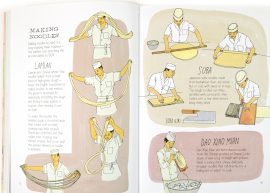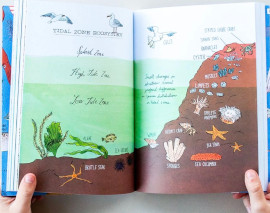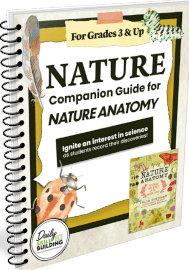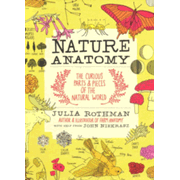Julia Rothman has written a series of four books on science topics (published by Storey Publishing): Farm Anatomy, Food Anatomy, Nature Anatomy, Ocean Anatomy, and Farm Anatomy. For each book, Daily Skill Building has created a Companion Guide that transforms Rothman’s books into courses for grades three and up. I reviewed Farm Anatomy separately but combine the other three courses in this review.
Rothman does a lovely job with each of the books, providing both the illustrations and the text. She has even written the text by hand, mostly in a manuscript style that looks like a typed font and sometimes in cursive. Her hand-drawn, full-color illustrations are sometimes very detailed and include labels. (e.g., the anatomy of a snail). Rothman credits Rachel Wharton for behind-the-scenes assistance with Food Anatomy and John Niekrasz for help with Ocean Anatomy and Nature Anatomy.
The Companion Guides, published by Daily Skill Building and designed for grades three and up, focus student attention and provide a means of evaluating how much students are learning from Rothman’s books. The Companion Guides have boxes in which students copy drawings from the books and label some of them, then also write answers to comprehension questions on the blank lines following each one. Lots of sketching is involved.
If you want to include younger children, you can purchase Daily Skill Building’s Junior Notebook digital add-on for each book. These consist of about 100 coloring and drawing pages rather than questions and boxes designated for specific drawings. Children can respond in a more open-ended fashion as Charlotte Mason recommends.
There are no answer keys for the Companion Guides, but correct answers are easy to find in the books. If parents want to use the Companion Guides as a notebooking exercise rather than for accountability, they don’t need to check answers.
Food Anatomy
 The first chapter of Food Anatomy: The Curious Parts & Pieces of Our Edible World begins with a four-page pictorial history of food; vocabulary words for flavors like piquant, umami, and saccharine; place settings and eating and cooking utensils from around the world; ovens and stoves; pre-modern methods of refrigeration; and fermentation.
The first chapter of Food Anatomy: The Curious Parts & Pieces of Our Edible World begins with a four-page pictorial history of food; vocabulary words for flavors like piquant, umami, and saccharine; place settings and eating and cooking utensils from around the world; ovens and stoves; pre-modern methods of refrigeration; and fermentation.
The next eight chapters focus on particular topics but still range into science, history, cultures, recipes, growing food, and serving it. Among the topics addressed are fruits, vegetables, grains, meat, fish, eggs, dairy products, street food, spices, drinks, and desserts. Plenty of recipes are included. The book provides a truly international exploration of foods and their ingredients.
Food: Companion Guide for Food Anatomy has a Note to Parents on page 1 that points out potentially problematic content in Food Anatomy: the timeline does not align with a Young-Earth viewpoint; beer and wine are mentioned in a few places, and there is a questionable Polynesian image. The Companion Guide does not include questions about such content, and parents can decide whether their children will read those sections in Food Anatomy. These possible issues are very small in contrast to the entire book, but it’s helpful to have them pointed out in advance.
Nature Anatomy
 Nature Anatomy: The Curious Parts & Pieces of the Natural World delves into earth science, space science, astronomy, botany, zoology, and bodies of water. But as with Rothman’s other books, the investigations range wide for each topic.
Nature Anatomy: The Curious Parts & Pieces of the Natural World delves into earth science, space science, astronomy, botany, zoology, and bodies of water. But as with Rothman’s other books, the investigations range wide for each topic.
For instance, in the first chapter we learn about the seasons caused by the Earth’s revolution around the sun, the layers of the Earth, minerals, the rock cycle, classifications of rocks, fossils, microfossils, landforms, tectonic plates, volcanoes, deserts, grasslands, coastal areas, swamps, bogs, field succession, and landscape painting. Yes, there’s an art lesson at the end of the chapter.
The other six chapters range just as widely through all facets of nature, although they don’t include art lessons.
Nature: Companion Guide for Nature Anatomy has significantly more pages than the other two Companion Guides, probably because it doesn’t skip any of Nature Anatomy’s content.
Ocean Anatomy
 In Ocean Anatomy: The Curious Parts & Pieces of the World Under the Sea, Rothman uses the first chapter to give us a “big picture” view of oceans by identifying the world’s oceans and their depths; discussing how the oceans were formed (based on an old-earth timeline); showing the features of the ocean floor; and explaining tides, currents, and waves. Along the way, she answers intriguing questions such as why the ocean is blue and why it is salty.
In Ocean Anatomy: The Curious Parts & Pieces of the World Under the Sea, Rothman uses the first chapter to give us a “big picture” view of oceans by identifying the world’s oceans and their depths; discussing how the oceans were formed (based on an old-earth timeline); showing the features of the ocean floor; and explaining tides, currents, and waves. Along the way, she answers intriguing questions such as why the ocean is blue and why it is salty.
Other chapters address fish, whales, dolphins, manatees, beaches, tide pools, shells, ocean and shore birds, crabs (and other shore creatures), sea cucumbers, starfish, squid, reefs, sponges, sea ice, glaciers, sea lions and related creatures, penguins, fishing, lighthouses, oceanography, sea commerce, garbage patches in the ocean, and climate change.
This book is fascinating, but it has more potential problems than the other three in the series. Evolutionary assumptions show up frequently, climate change and environmental issues are raised several times, and different types of reproduction in marine creatures are discussed and illustrated in some instances. The Companion Guide skips over the questionable material, although parents can still have students read those sections in Ocean Anatomy if they wish. Parents concerned about any of these issues might want to use this course with older students who have more understanding of conflicting viewpoints and sexual functions.
Summary
Julia Rothman’s books offer a delightfully different way to study science. And the Companion Guides and Junior Notebook add-ons provide convenient ways for students to record and draw what they are learning, making these practical courses for families to do together.











